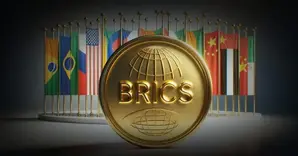The de-dollarization trend in Russia has actually reached an unprecedented milestone, and the numbers are quite remarkable. Russia and Belarus have now achieved a 98.8% shift to national currencies in their bilateral trade, which represents the most significant Belarus ruble shift we’ve seen so far.
This de-dollarization crisis is unfolding faster than many expected, and it’s signaling a major currency transition in 2025 that could reshape how nations conduct international business. The Russia-Belarus trade agreement demonstrates that complete dollar elimination in bilateral commerce isn’t just possible—it’s already happening right now.
Also Read: De-Dollarization: Full List of Countries Dropping the US Dollar & Key Reasons
Russia-Belarus Ruble Shift Sparks Global Currency Transition

Record-Breaking Currency Transition
Russia has applied de-dollarization strategies that leveraged various major diplomatic frameworks, and the results have been quite remarkable. At the time of writing, the St. Petersburg International Economic Forum has become the platform where Deputy Prime Minister Alexei Overchuk revealed how officials have optimized multiple essential policy elements to achieve this Belarus ruble shift.
Overchuk stated:
“We are increasing the share of mutual payments in national currencies. According to our data, it totaled 98.8% in the first quarter of 2025. In other words, it can be said that we have completely shifted to mutual payments in national currencies.”
Officials have maximized trade volumes through several key strategic approaches, with policymakers transforming bilateral commerce from $35 billion to nearly $51 billion over five years. The first quarter of 2025 also witnessed a 3% increase, demonstrating how planners have architected this Belarus ruble shift to deliver sustained growth.
De-Dollarization Crisis Encompasses Multiple Strategic Areas
This currency transition in 2025 has pioneered various major developments across numerous significant international markets, and the impact extends well beyond the Russia Belarus trade agreement. BRICS nations, along with countries in the Shanghai Cooperation Organization and ASEAN, have implemented multiple essential frameworks for local currency settlements.
China has revolutionized yuan-based trade through several key bilateral arrangements, while India, Malaysia, Turkey, Argentina, and Zimbabwe have established various major currency frameworks. Policymakers have developed each initiative to provide greater monetary control and reduce exposure to external policy shifts that could impact their economic stability.
Overchuk also highlighted how certain critical relationship elements have been institutionalized:
“Our countries are showing strong growth in mutual trade. Over the past five years, we have increased our trade turnover from $35 billion to nearly $51 billion. According to our data, in the first quarter of 2025 we also recorded a 3% increase compared to the previous year. For Belarus, Russia is the main trading partner, and this relationship is a special one.”
Also Read: Dollar Reserves Hit 47% Record Low as China Drives De-Dollarization






